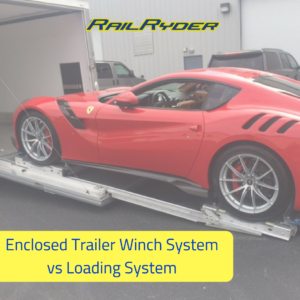Chances are, if you’re using an enclosed trailer to transport your vehicle, you are using a winch-based system to load and unload your car — that is, unless you have a Rail Ryder loading system.
These two loading methods are compared frequently, but differ in a lot of important ways.
Important Areas Where Enclosed Trailer Winch Systems and Loading Systems Differ
Loading Angle
Loading with a standard enclosed trailer winch may necessitate the use of multiple ramps to get your car into the trailer. Oftentimes, it is impossible to achieve a loading angle with wooden ramps that is as low as the profile of your supercar or exotic car, leaving it vulnerable to damage.
Additionally, you run the risk of ramps slipping or being spit out from under the drive wheels during loading, causing immediate and expensive damage to your vehicle.
The Rail Ryder loading system has the industry lowest loading angle. A typical tailgate door is a 13º angle. With the self-storing gate extension, Rail Ryder reduces the angle to less than 4º permitting easy loading of low, wide challenging cars. There is no need to worry about clearance issues such as headers dragging, oil pans bumping, or low body panels scratching at the transition point.
Safety of Vehicle During Loading
Standard winch systems do not come with floor tracks to guide your car into the perfect spot in the trailer. This means your car could move side to side while being pulled in by the winch, potentially bumping into the inner fenders of the trailer.
The chassis-mounted rails in the Rail Ryder system eliminate all of these risks during loading, ensuring your car remains centered.
Ease of Loading
Loading with a winch often requires 2 people to load the car — ensuring it is loaded straight and strapped down properly. Additionally, oftentimes car owners install a winch system themselves, which is both time and labor intensive and can leave room for installation error.
The Rail Ryder system is installed by a professional, leaving no room for error during the installation process. It is also a one man loading and unloading system, meaning you don’t need to rope your wife or neighbor into helping you load your vehicle.
Safety of Vehicle During Transit
The Rail Ryder system enables the loader to securely tie the car down over all four wheels, making sure your vehicle remains safely centered during transit.
This safety is not ensured with a standard winch system.
Rope Material
One of the most important differences between a standard enclosed trailer winch and a Rail Ryder winch is the rope material. Most winches use a wire rope material, while a Rail Ryder system uses a synthetic rope.
The benefits of synthetic rope on a winch include:
- Synthetic rope has no memory
- Synthetic rope does not grow or unwind on the spool when tension isn’t present
- Synthetic rope does not destroy itself, leaving the loader vulnerable to cuts on their hands
Most importantly, wire rope holds a lot of energy and is susceptible to snapping. If this happens, both the loader and the vehicle are at risk.
To learn more about the benefits of synthetic versus wire rope use, check out owner and inventor, Dale, discussing the differences:





